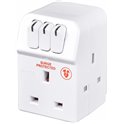Surge Protection 13a 3 way switched socket- Plug
If you are buying a Mk 7 Power Pro headstock in my opinion one of these is essential.
This item is supplied with any new Mark 7 Power Pro units sold by me to protect the computer chipset in your new headstock.
Your new Mark 7 Power Pro has an onboard computer which has all the data for the settings required to control the electric motor.
Protecting this unit from lightning strikes and power surges will prolong the life of your investment.
Manufactured to BS1363/A.
Meets all Health & Safety standards

 there are a few designs
there are a few designs
Over the years in my dealings with computer products I came to realise that many problems I experienced were down to power fluctuations to the power supply feeding the equipment. These fluctuations make little difference to normal items but can cause problems if computer processors receive a “spike” in electricity. It can cause them to “lose” the information contained in the internal chips of the circuit board. All of the settings for the Power Pro are held on the memory chips in the circuit board and it is this I feel should be protected.
The device has two extra plug in points for your radio and a laptop if you use these in your workshop.
A wikipaedia explanation is below for those of you who wish to read it.
A surge protector (or surge suppressor) is an appliance designed to protect electrical devices from voltage spikes. A surge protector attempts to limit the voltage supplied to an electric device by either blocking or by shorting to ground any unwanted voltages above a safe threshold. This article primarily discusses specifications and components relevant to the type of protector that diverts (shorts) a voltage spike to ground; however, there is some coverage of other methods.
The terms surge protection device (SPD), or transient voltage surge suppressor (TVSS), are used to describe electrical devices typically installed in power distribution panels, process control systems, communications systems, and other heavy-duty industrial systems, for the purpose of protecting against electrical surges and spikes, including those caused by lightning. Scaled-down versions of these devices are sometimes installed in residential service entrance electrical panels, to protect equipment in a household from similar hazards.[1]
 Maximize
Maximize 





































 there are a few designs
there are a few designs






